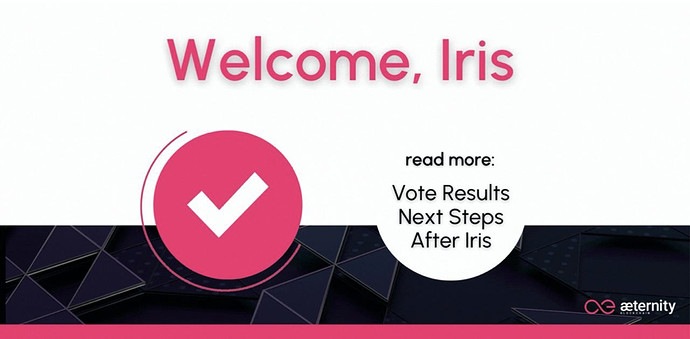After the first three planned hard forks, namely Minerva (March 2019), Fortuna (June 2019) and Lima (October 2019) now comes the Iris hard fork (April 2021). The Iris release is the first one that was not planned in the initial roadmap and implies changes in the consensus rules, so it was subject to a community vote which ran from March 15th to Apr 14th at 01:36:39 AM CET, when the vote ending block 414020 was solved. Please note that blockchains do not know about dates and hours but about block numbers and the estimated vote ending date can change.
The community support has spoken, with a bold 99,99 % YES in favor of the IrisHardFork . The full results and instructions to verify the poll can be found here:
What is so exciting about the Iris Hard Fork?
As explained in the AMA Session held last Friday Apr 9th, this update includes features that bring significant improvements in practically every component of the æternity protocol , our FATE virtual machine, oracles, state channels, the æternity naming system (AENS), generalized accounts, etc.
Let us highlight some points which are enabled by the Iris Hard Fork release:
-
Improved overall database stability and performance;
-
New cryptographic primitives included in the virtual machine which allow running Zero Knowledge proofs and advanced multi-signature schemes on top of æternity;
-
Contract factories and contract cloning are now possible with Sophia smart contracts increasing usability and security in general, particularly for DeFi services;
-
Users can now execute transactions with a third party paying for the gas , which will result in a much smoother onboarding experience for æpp users;
-
State channels participants can have separate delegates, which can then also do more.
If you want to dive deeper into the rich set of improvements that Iris provides you can have a look at the extended description of the Iris Improvements and the Iris Process.
What comes next?
First step was obtaining the community agreement to move forward to Iris. Now that is clearly achieved and the community has expressed their support for Iris. The next steps are as follows:
An Iris Hard Fork release candidate has been published on Github for testing purposes. We encourage node operators to update to the release candidate locally and provide any relevant feedback about the improved database stability and performance. As a node operator you can see in the logs how the database migration is progressing, and how the migration affects your node. If there is any problem and a need for bug fixing please inform us as fast as possible in order to improve and make the Iris release stable. The æternity core developers need your fast support for the main testing.
Once the Iris release is considered final, after the testing phase , æternity crypto foundation will announce that miners and node operators have a time window of 14.400 key blocks (approximately 30 days) to update their nodes. The hard fork activates at the block number exactly 14.400 blocks after the block in which the final release is made.
After Iris
After Iris activation, we continue the work of keeping æternity the most advanced blockchain in existence, thus we highly encourage the community to propose new features to be included in the next hard forks. Æternity is yours and we want you to have a louder voice in the development of the æternity technology and æcosystem. Your æternity features proposals are appreciated!
We are proud to have become stronger thanks to the vibrant and committed community that can influence the future of the network, fulfilling the vision of æternity contributing to a more decentralized, private and free world .
Get in touch: GitHub | Forum or just send an Email to [email protected]
